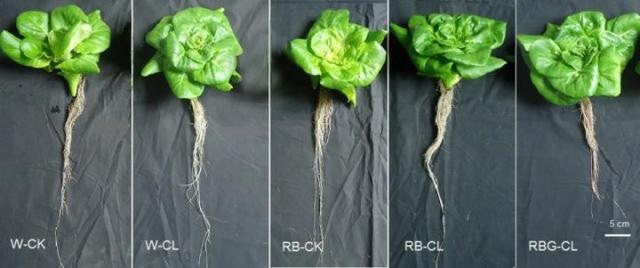May 11 2016
Increasingly, vegetables are being efficiently grown using soilless techniques such as hydroponics. Hydroponic systems are favored for their ability to improve water and nutrient use efficiency and crop yields, and have the added benefit of allowing growers to use fewer chemical fertilizers. Researchers in China and United Kingdom studied the effects of LED light combinations on lettuce grown in hydroponic systems to determine whether the treatments could reduce nitrate accumulation, and to find out what effect the treatments might have on phytochemical levels.
 24 hours continuous RB LED with G light exposure significantly enhanced free-radical scavenging activity, decreased nitrate content, and enhanced preharvest lettuce quality. (CREDIT: Photo courtesy of Professor Yang Qi-Chang.)
24 hours continuous RB LED with G light exposure significantly enhanced free-radical scavenging activity, decreased nitrate content, and enhanced preharvest lettuce quality. (CREDIT: Photo courtesy of Professor Yang Qi-Chang.)
"Vegetables, especially leaf vegetables, grown in hydroponics can accumulate high levels of nitrate and other harmful substances," explained Qi-Chang Yang and Chungui Lu, corresponding authors of the study published in the Journal of the American Society for Horticultural Science. "Previous research on the effects of continuous light on photosynthesis and plant growth has mainly focused on the circadian clock and induced injury. Less is known about the effect of continuous LED light on the response of the photosynthetic system and on changes in the concentrations of antioxidant substances and phytochemicals."
The researchers designed experiments with continuous light (CL) and/or the combination of green (G) with red-blue (RB) LED light to determine whether the treatments could decrease nitrate content and increase nutrient contents in hydroponically grown lettuce. The experiments included white LED light and combined red-blue LED light (with or without green LED light) in five combinations.
"Our results clearly showed that continuous light by RB and RBG LED dramatically affects the nitrate content of lettuce at preharvest stage," the authors said. "Nitrate content reduced dramatically under both RB-CL and RBG-CL treatments between 0 and 24 hours."
Results also demonstrated that RB LED light was more effective than white LED light in facilitating lettuce growth. "Continuous LED light for 24 hours significantly enhanced free-radical scavenging activity and increased phenolic compound concentrations," the authors said. They recommended treatments of 24 hours continuous RB LED with G light exposure to decrease nitrate content and enhance lettuce quality.